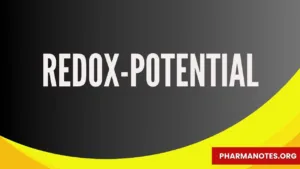Redox Potential

Objective
• At the end of this lecture, student will be able to
• Explain Redox-potential
• Describe the enzymes and co-enzymes involved in oxidation reduction
Biological Oxidation
• Oxidation is defined as the loss of electrons and reduction as the gain of electrons. E.g. Interconversion of ferrous ion (Fe2+) to ferric ion (Fe3+)
• The electron lost in the oxidation is accepted by an acceptor which is said to be reduced. Thus, the oxidation-reduction is a tightly coupled
• The general principle of oxidation-reduction is applicable to biological systems also
• E.g. Oxidation of NADH to NAD+ coupled with the reduction of FMN to FMNH2
• There are two redox pairs NADH/NAD+ and FMN/FMNH2 the redox pairs differ in their tendency to lose or gain electrons
Redox Potential (Eo)
• The oxidation-reduction potential or simply, redox potential is a quantitative measure of the tendency of a redox pair to lose or gain electrons
• Redox pairs are assigned specific standard redox potential (Eo volts) at pH 7.0 and 25oC
• The more negative redox potential represents a greater tendency to lose electrons
• The electrons flow from a redox pair with more negative Eo to another redox pair with more positive Eo
• The redox potential (Eo) is directly related to the change in the free energy
Enzymes and co-enzymes involved in oxidation reduction
• Biological oxidation is catalyzed by enzymes, which function in combination with coenzymes or electron carrier proteins
1. Oxido-reductases: these enzymes catalysed the removal of hydrogen from substrate and add the other substrate e.g. glyceraldehyde-3-phosphate dehydrogenase
2. Oxidases: these enzymes catlyse the removal of hydrogen from the substrate and add directly to the molecular oxygen e.g. Cytochrome oxidases, tyrosinases, uricases etc
3. Oxygenases: these enzymes incorporate oxygen in to the subatrate
a. Mono-oxygenases: add one atom of O2 to the substrate
b. Di-oxygenases: add both the atom of O2 to the substrate
4. Aerobic dehydrogenases: these enzymes remove hydrogen from the substrate and add it either directly to oxygen or any other artificial acceptor like methylene blue and the product formed is H2O2
5. Anaerobic dehydrogenases: these enzymes use other substrate to donate the hydrogen. They transfer hydrogen to other hydrogen acceptor, but not directly to oxygen. Thus hydrogen acceptor are NAD, FMN, FAD, cytochrome also receive hydrogen (b, c1, a, a3)
6. Hydrogen peroxidases: these enzymes have either hydrogen peroxide or organic peroxide as their substrate.
There are two types of hydrogen peroxidases
1. Peroxidases
2. Catalases
Their prime function is to destory H2O2
Summary
• Oxidation is defined as the loss of electrons and reduction as the gain of electrons
• The oxidation-reduction potential or simply, redox potential is a quantitative measure of the tendency of a redox pair to lose or gain electrons
• Biological oxidation is catalyzed by enzymes, which function in combination with coenzymes or electron carrier proteins
FAQs
- What is the significance of redox potential in chemistry? Redox potential provides insights into the electron transfer capabilities of chemical species and determines the direction and spontaneity of redox reactions.
- How is redox potential measured experimentally? Redox potential is measured using standard electrode potentials relative to a standard hydrogen electrode under standard conditions.
- What factors influence the redox potential of a system? The redox potential of a system is influenced by the concentration of reactants and products, temperature, pressure, and the nature of the electrochemical interface.
- What are some practical applications of redox potential? Redox potential is used in environmental monitoring, industrial processes, electrochemical synthesis, and biological energy metabolism.
- How does redox potential contribute to ATP synthesis in biological systems? Redox potential gradients established by electron transfer reactions drive proton pumping across membranes, which powers ATP synthesis through oxidative phosphorylation.
Also, Visit:
B. Pharma Notes | B. Pharma Notes | Study material Bachelor of Pharmacy pdf


